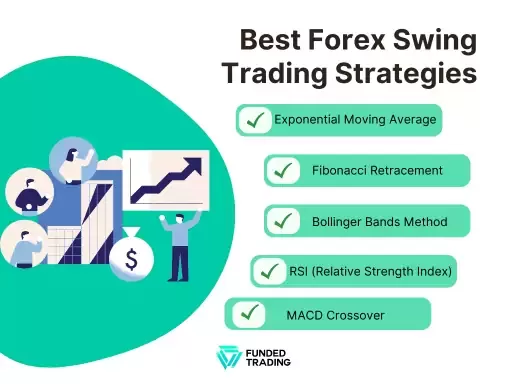Introduction
Being one of the most used trading strategies, swing trading relies heavily on technical analysis to inform trading decisions. Let’s quickly review swing trading before we begin to explore the advantages of various swing trading strategies.
What is Swing Trading
Swing trading is a trading strategy where traders aim to capture short- to medium-term price movements in a financial market by buying low and selling high within a relatively short time frame. Like any other forex trading method, it makes predictions about the direction of currency pairs using technical and fundamental analysis.
Pros
- Capture frequent short-term price changes in a market landscape that evolves at a much slower rate.
- Trading can be made simpler by allowing traders to only use technical analysis.
- trading takes less time than day trading.
- An average trader can profit by 2% on each transaction.
- While the trades might last for weeks, there is no need to spend a lot of time tracking trends.
Cons
- To effectively evaluate charts, you must be able to learn new things rapidly.
- Frequently ignore longer-term patterns in favor of temporary market movements.
- Trading holdings are vulnerable to weekend and overnight market risk.
- Unexpected market reversals can cause large losses.
- Swing trading involves the possibility of overnight risks.
What Is A Swing Trading Strategy?
A swing trading strategy is an approach to trading where traders try to take advantage of short- to medium-term price swings in the market by buying assets when they are perceived as low and selling them when they are deemed high within a relatively brief period of time.
Swing trading derives its name from the fact that it seeks to profit from price oscillations or upward or downward swings. Only at a time frame similar to position trading do swing traders, like day traders, use various technical trading tools.
The swing trading strategy’s profit target is a more reasonable 10%, or possibly just 5% in more challenging situations. Those kinds of returns might not appear to be the kind of reality benefits often anticipated in the stock market, but this is where the time factor comes into play.
To strengthen your swing trading strategies, you might attempt a number of different ways. One of them is to look at a longer-term chart and attempt to align your trade with the long-term trend. Attempt to trade only when the trend’s long-term direction is followed.
Best Forex Swing Trading Strategies

Exponential Moving Average
The exponential moving average, also known as the EMA, is a blending technique created by adding a piece of the price at which the asset is currently trading to a portion of the value of the preceding moving average. This indicator can be utilized to offer trading signals, as we saw with the exponential moving average crossover technique, in addition to assisting with trend confirmation.
The price will always fluctuate before the EMA reacts since it uses historical data. Because it gives more weight to more recent values, an exponential moving average will react to newer data more quickly.
Fibonacci Retracement
Fibonacci retracement levels link any two points that the trader considers significant, usually a high point and a low one. The percentage levels show areas, where the price could stop or reverse.
If the price in a downtrend retraces to and rebounds off the 61.8% retracement level, a stock swing trader may open a short-term sell position with the intention of exiting the sell position at a profit when the price declines to and bounces off the 23.6% Fibonacci line.
Bollinger Bands Method
Bollinger Bands (BB) are price bands that are set on both sides of a trend line. It establishes a trading range for assets. Bollinger Bands are a tool used by swing traders to plot market entry and exit positions. Swing trading can greatly benefit from its primary reflection of market volatility. This is due to traders’ rapid ability to predict the direction of the market before initiating a position.
RSI (Relative Strength Index)
The Relative Strength Index, also known as RSI, is an oscillating indicator used to assess a stock’s momentum, which is defined as the rate and magnitude of price fluctuations. Investors frequently use this indicator to determine if a stock is overbought or oversold.
The charts only employ numbers from 0 to 100, so they are simple to read. It aids traders in recognizing overbought and oversold markets. As a result, traders are able to plan when to establish trading positions.
MACD Crossover
This is one of the most widely used swing trading indicators for identifying trend direction and reversals. The MACD is made up of two moving averages, the MACD line and the signal line, and when these two lines cross, buy and sell signals are produced. A stock swing trader would then hold onto the transaction until the two lines crossed again, generating a signal for a trade in the other direction.
How to Start Forex Swing Trading
- Open a live trading account, and if you want to practice first, you can also create a demo account.
- Trend reversals and other price signs can be identified using technical analysis tools, which will assist guide your swing trading attempts.
- Choose the asset and time range for your swing trade after conducting your research.
- To reduce any risks, include a stop loss and take profit order. Your trades will remain consistent and pertinent to your trading strategy with the aid of these risk management tools.
- Keep an eye on your position and pay attention to disruption, gapping, and shifts in the atmosphere of the market.
- Close the trade in accordance with your swing trading technique if the trade has not been closed by your stop loss.
Conclusion
Swing trading, in its most basic form, aims to make quick gains over a few days or weeks. To profit from price swings to the upside, downside, or between technical support and resistance levels of support and resistance, swing traders may go long or short in the market.
Swing trading may not be the best option for you if you have a low-risk tolerance or insufficient risk capital. But if you’re ready to master swing trading and have the necessary tolerance for risk as well as capital, you might find it to be a useful ability to complement your longer-term investments.
Finding exit points in advance is the best strategy to eliminate emotion from trading and guarantee a logical approach to the markets. Waiting till you have an opening will make it too late. practice patience, and keep in mind that all it takes is one profitable swing trade per month to generate substantial profits.






